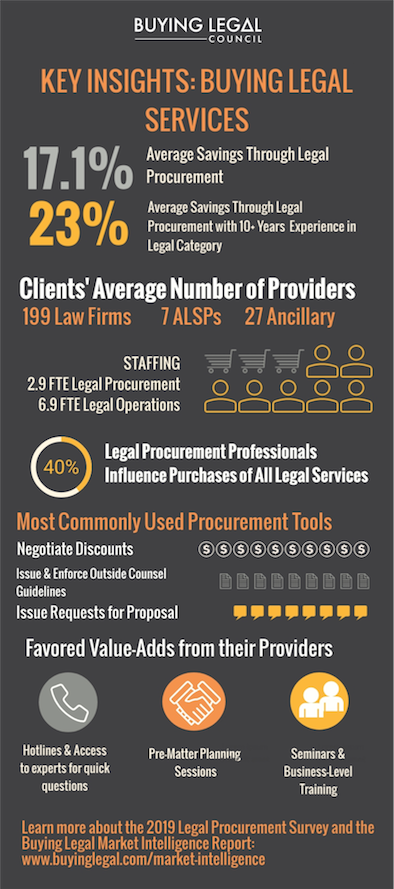According to a recent survey by the international trade organization Buying Legal® Council, with legal procurement’s help, companies save millions. These savings, through cost reductions and cost avoidances translate into significant savings per share for public companies.

Procurement is clearly earning its seat at the table (at least from the CFO’s point of view), as the survey findings suggest that legal procurement professionals were able to save their employers 17.1 percent on average. (Last year saw an average of 14.6 percent in savings due to procurement’s involvement, and the year prior it was 11.4 percent.) To put it in perspective, for a company spending $200 million on outside legal services, this translates into $34.2 million saved. The most successful legal procurement professionals saved their employers 24 percent on average. (In our above case, this would mean $48 million saved.)
It is typically the CFO who wants procurement to help the legal department with buying legal services, although a new wave of general counsel are aware of the benefits of working with dedicated legal procurement professionals.
And it’s not only in savings where companies benefit from legal procurement. A competent legal procurement team is worth their weight in gold. They bring to the party a range of skills, knowledge and experiences that drive costs down. They know what questions to ask, what data to collect, and how to get more for less.
For legal procurement to be successful, it is important to clearly stake out the grounds and clarify responsibilities. Professional legal procurement includes all vendor management activities including:
- Managing the selection of vendors, including the use of RFPs
- Establishing payment terms
- Negotiating contracts and managing fee proposals
- Monitor regulatory compliance as well as compliance with agreed engagement terms
- Collect and evaluate data on services delivery by preparing decision-grade data
Legal Operations, on the other hand, is responsible for legal department administration and organizations activities including:
- Evaluating and implementing technology solutions
- Optimizing the management of the legal department
- Managing internal resources
- Managing external providers
Virtually all procurement tools see a rise in adoption rates. Procurement uses an expansive range of procurement tactics when buying legal services. According to the research, almost every client negotiates discounts: Eighty-eight percent of survey respondents already negotiate discounts with legal services providers on behalf of their employers and an additional three percent plan to use this tactic in the future.
Legal procurement professionals with longer tenure in the category appear to use a wider range of procurement tools than those newer to legal services. After a round of picking low hanging fruit, legal procurement professionals are likely to experiment with different tools. This sets them up for success as they get a chance to see what works well and how to best apply different tools.
However, legal spending is on the rise as a result of a spike in complexity and number of legal issues. The size of a company (in terms of annual revenues) determines the percentage of legal spend: A company with revenues between $4.1 billion to $25 billion (think Fortune 500), spends an average of $173 million on legal, that is, it will spend between 0.6 and 4.2 percent of its revenues on legal services, while a company with revenues between $501 million to $1.7 billion could expect to spend between 1.8 and 6.2 percent of its revenues—or $31 million—on outside legal services. The bulk of this new spending is directed at law firms as clients may tend to rely on more traditional outside legal providers under such circumstances.
This spike in legal spending has not caused legal procurement to move into a cost-cutting frenzy: Controlling, not slashing, legal spending is the core goal although procurement’s success and percent of savings are higher than ever.
Legal procurement continues to increase its influence and reach as law departments are forced to find ways to manage (and, if possible, reduce legal spend) without a negative impact on the quality of advice received or the outcomes achieved: Forty percent of legal procurement professionals in the survey stated that they influenced purchases of all legal services, and 55 percent said they influenced purchases of some legal services. (Five percent stated to have no influence on the purchase of legal services).
Given their overall rise in influence and success with savings, confidence is up among legal procurement professionals. They are able to use a professional procurement approach for legal services in a productive way, driving value and competitive advantage for their employers. Legal procurement professionals are contributors to the success of their organizations, able to reach their goals and fulfill their corporate mandate of better managing legal spend and supporting the legal department in data-driven decision-making.
To get the insights for your legal procurement strategy, you can download the executive summary here, and the Buying Legal® Market Intelligence is available for Members and Friends free of charge and can be purchased by all others.
Published June 6, 2019.




